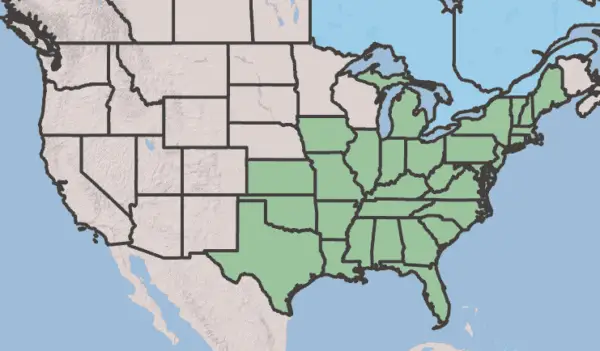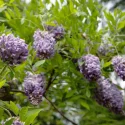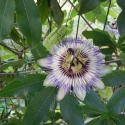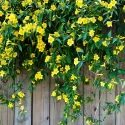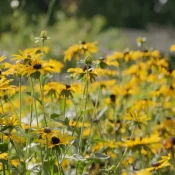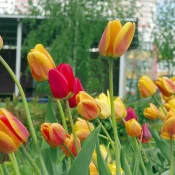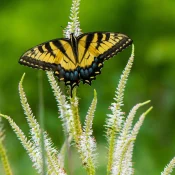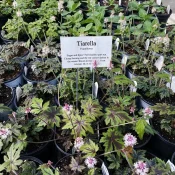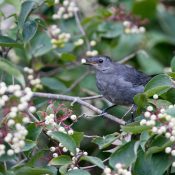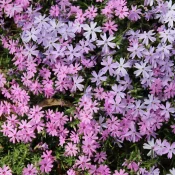Coral Honeysuckle
Coral Honeysuckle is a native vine beloved by hummingbirds. They are fast-growing, low maintenance, and semi-evergreen, which means most of the leaves will stay on year-round, even in cold climates. They flower with bright red tubular flowers continuously in the spring and summer. Plant this vine on a sunny or part-sunny trellis and watch it return decades of beauty.
- Full Sun, Part Sun
- Vine
- Summer flowers, Fall flowers
- Hummingbird favorite
Tip: plant Coral Honeysuckle outside your window
Coral Honeysuckle is an amazing, fuss-free native vine that grows effortlessly in half of the United States and parts of Canada. Native plants are essential choices for our gardens and landscapes because they provide beauty with minimal work, alongside crucial food and homes for wildlife (like hummingbirds!)
In this article, we’ll share some tips for planting and landscaping with Coral Honeysuckle, along with some ideas on where to find some for your garden.
What are the benefits of planting Coral Honeysuckle?
Native plants are plants that have grown in a region for thousands of years (sometimes even millions!) They know the soil, climate, and weather better than any other plants on earth.
Planting the plants native to your region returns many benefits, including:
- Wildlife support. Native plants are the preferred food and homes of all the iconic wildlife we love—hummingbirds have a special bond with Coral Honeysuckle.
- Fuss-free beauty. The native plants in your home area naturally grow without human intervention, making planting native even easier than lawn care.
And one more benefit to mention…
Coral Honeysuckle is perfect food for hummingbirds
One of the most fun benefits of this plant is its ability to attract hummingbirds. Coral Honeysuckle’s brightly colored flowers, ranging from shades of red to orange, produce nectar that hummingbirds love to eat.
The shape of the flowers has evolved to be exactly the shape for hummingbird beaks. This vine is sometimes called the “hummingbird vine” due to its popularity among the small, iconic birds.
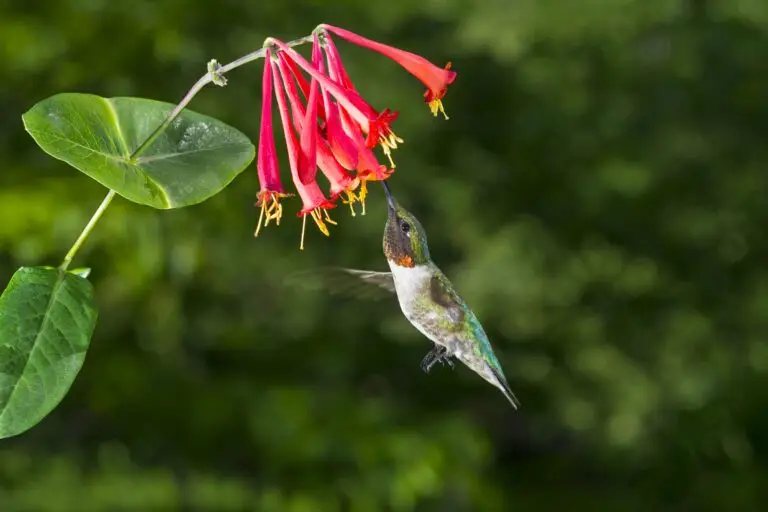
Where should you plant Coral Honeysuckle?
Do you have a trellis, fence, or structure that you’d like to cover in flowers and semi-evergreen leaves? That’s the perfect spot for Coral Honeysuckle.
Even if you’re not a birdwatcher, Coral Honeysuckle is a wonderful choice when you’re looking for a vine. Vines are perfect for trellises, fences, or other structures where you’d like something green and flowering.
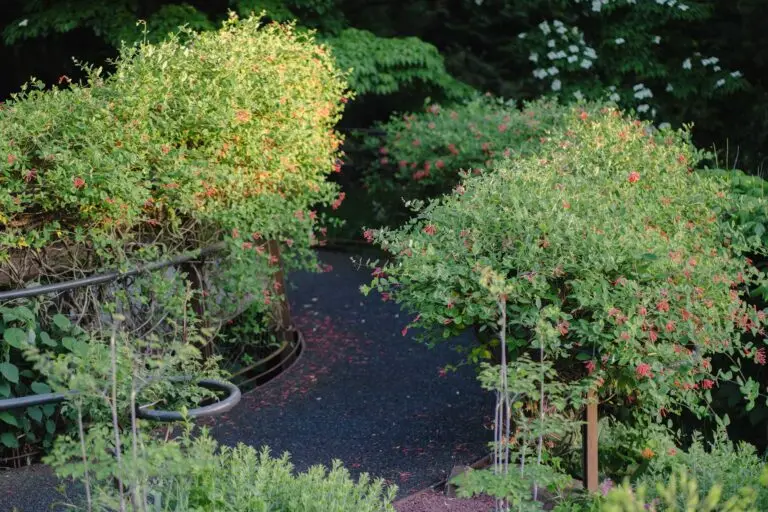
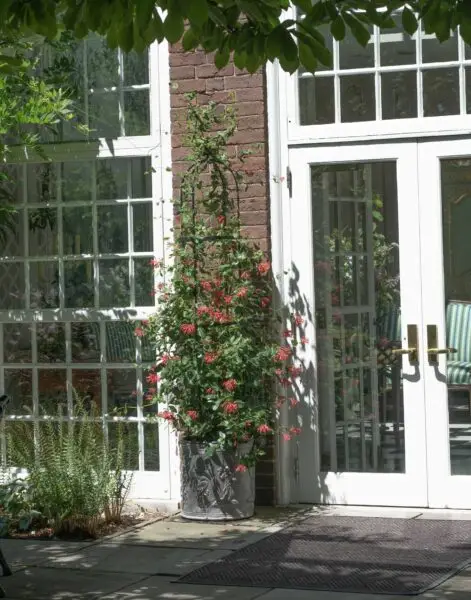
Plant it where you can see it
Want to watch hummingbirds while you sip coffee? Plant it where you can see from inside your home. (Scroll up to the beginning video for proof!)
Hummingbirds are skittish creatures, but they do feed regularly—especially during the spring and summer. Plant Coral Honeysuckle where you can watch hummingbirds visit its flowers throughout the spring into early fall.
When does Coral Honeysuckle bloom?
Coral Honeysuckle can grow up to 20 feet tall and blooms continuously from late spring to early fall. Throughout the summer, the trumpet-shaped flowers—roughly two inches in length—cover the vine.
Four seasons of Coral Honeysuckle
Spring
The vine wakes up as temperatures rise, putting out fresh green leaves and growing its tendrils. Expect spring to be a huge burst in the vine’s growth. This is also when the vine puts out its distinctive flowers. The amount of flowers depends on the amount of sun: sunny spots will get more flowers than shady ones. And then here come the hummingbirds!
Summer
As the flowers fade, they turn into bright red berries—another bird treat. Smaller songbirds will bury themselves in the vine, chowing down on the berries.
Fall
During the fall season, the leaves turn a brilliant range of yellow and orange hues.
Winter
Coral Honeysuckle is a semi-evergreen vine; some of its leaves will persist even in cold, snowy winters.
Where can I find Coral Honeysuckle to buy?
Sadly, sourcing native plants can be challenging at conventional plant nurseries. To help you find some quickly, here are four resources to check out:
Where can I find seeds and plants?
Finding native plants can be challenging (we partly blame Marie Antoinette.) To make it easier, we’ve assembled four sourcing ideas.
Native Nursery List
300+ native nurseries makes finding one a breeze
Online Native Plant Sellers
We've included 100+ online resources to help
Society Plant Sales
Every state has a native plant society; find yours
Online Communities
Local Facebook groups are a great plant source
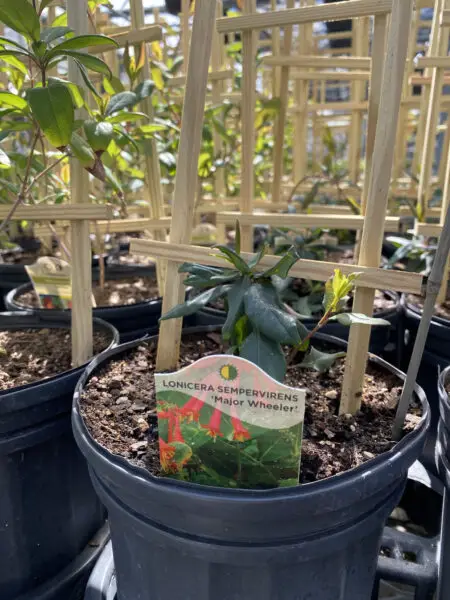
A quick tip when you visit the nursery
Coral Honeysuckle can sometimes look blah when you buy it
You see the pictures at the beginning of this article and imagine a curtain of red flowers covered in hummingbirds. This is going to take a few years.
The good news is that—like most vines—Coral Honeysuckle is a super fast grower. So what looks small at the nursery will be the vine of your dreams in a few years. Start small and dream big.
What to plant with Coral Honeysuckle
Plant other hummingbird and pollinator-friendly plants in your sunny garden. Some favorites include:
Overall, the native vine Coral Honeysuckle is a stunning and versatile plant that brings a splash of color to your garden. If you like hummingbirds (and who doesn’t?!), consider planting a few vines to encourage these delightful birds to visit your garden. Visit our guide to planting a hummingbird garden if you’d like to make a hummer paradise (and also see a video of a hummingbird in a sprinkler—no joke!)
Sources
- Nelson, Gil. Best Native Plants for Southern Gardens: A Handbook for Gardeners, Homeowners, and Professionals, (2010).
- Harstad, Carolyn. Go Native! Gardening with Native Plants and Wildflowers in the Lower Midwest. (1999), 209-210.
- Lorimer, Uli. The Northeast Native Plant Primer. (2022), 120.
